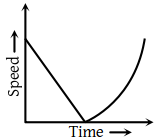The v – t graph of a moving object is given in figure. The maximum acceleration is:

1.
2.
3.
4.

Velocity-time curve for a body projected vertically upwards is
1. Parabola
2. Ellipse
3. Hyperbola
4. Straight line
An object is moving with a uniform acceleration which is parallel to its instantaneous direction of motion. The displacement (s) – velocity (v) graph of this object is
| 1. |  |
| 2. |  |
| 3. |  |
| 4. |  |
A ball is thrown vertically upwards. Which of the following plots represents the speed-time graph of the ball during its height if the air resistance is not ignored
| 1. |  |
| 2. |  |
| 3. |  |
| 4. |  |
| Assertion (A): | Displacement of a body may be zero when distance travelled by it is not zero. |
| Reason (R): | The displacement is the longest distance between initial and final position. |
| 1. | Both (A) and (R) are True and (R) is the correct explanation of (A). |
| 2. | Both (A) and (R) are True but (R) is not the correct explanation of (A). |
| 3. | (A) is True but (R) is False. |
| 4. | Both (A) and (R) are False. |
Read the assertion and reason carefully to mark the correct option out of the options given below:
(1) If both assertion and reason are true and the reason is the correct explanation of the assertion.
(2) If both assertion and reason are true but reason is not the correct explanation of the assertion.
(3) If assertion is true but reason is false.
(4) If the assertion and reason both are false.
Assertion : The equation of motion can be applied only if acceleration is along the direction of velocity and is constant.
Reason : If the acceleration of a body is constant then its motion is known as uniform motion.
A particle moves along the sides AB, BC, CD of a square of side 25 m with a velocity of 15 ms-1. Its average velocity is
(1) 15 ms-1
(2) 10 ms-1
(3) 7.5 ms-1
(4) 5 ms-1
If the body covers one-third distance at speed v1, next one third at speed v2 and last one third at speed v3, then average speed will be
(1)
(2)
(3)
(4)
The displacement of the particle varies with time according to the relation . Then the velocity of the particle is:
(1)
(2)
(3)
(4) None of these
A particle is moving in a straight line and passes through a point O with a velocity of 6 ms–1. The particle moves with a constant retardation of 2 ms–2 for 4 s and there after moves with constant velocity. How long after leaving O does the particle return to O
(1) 3s
(2) 8s
(3) Never
(4) 4s







